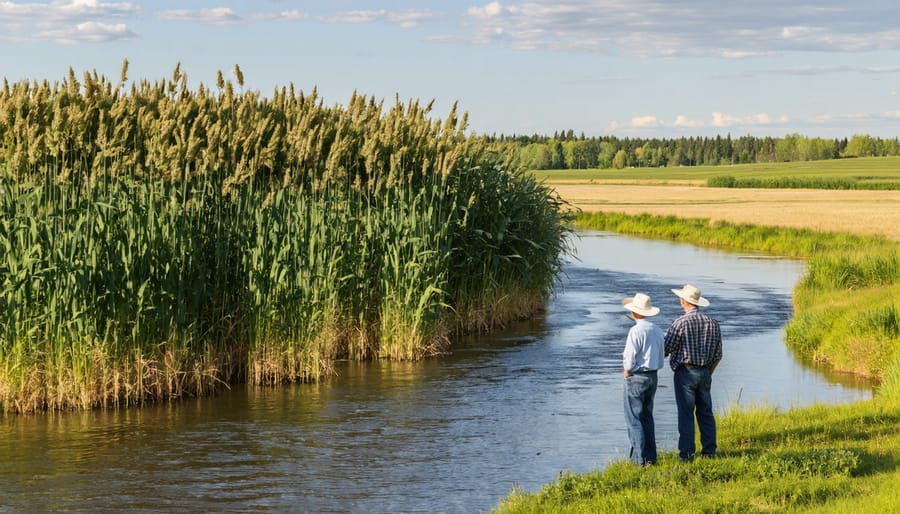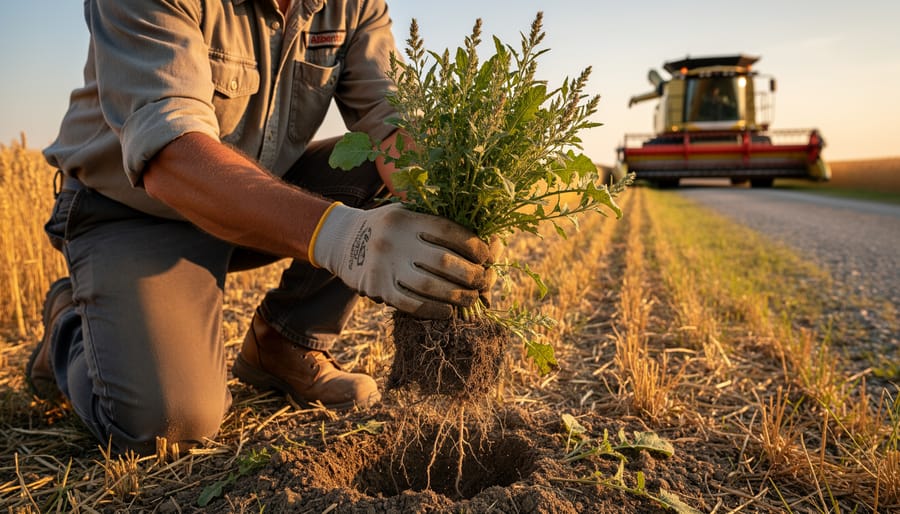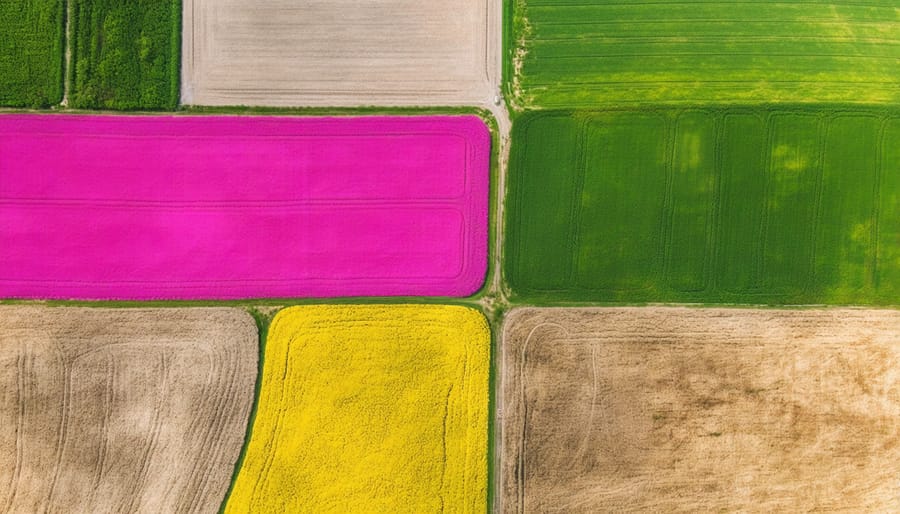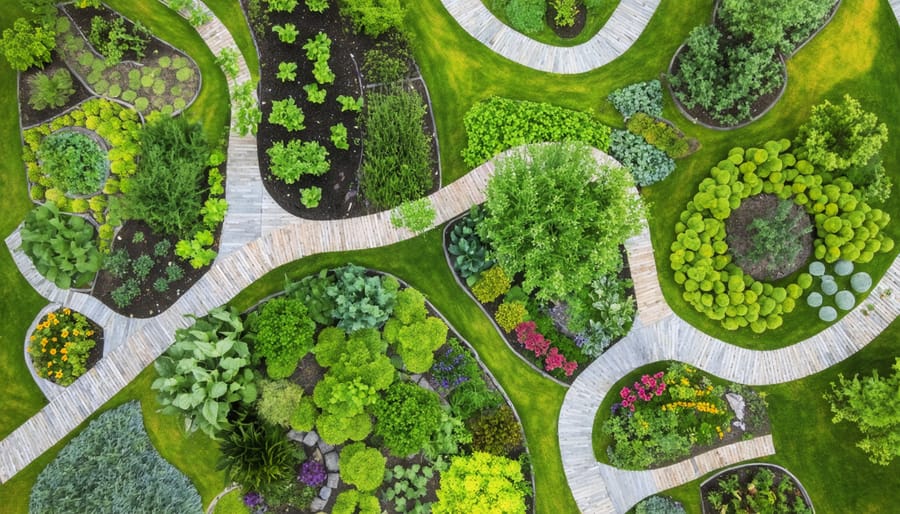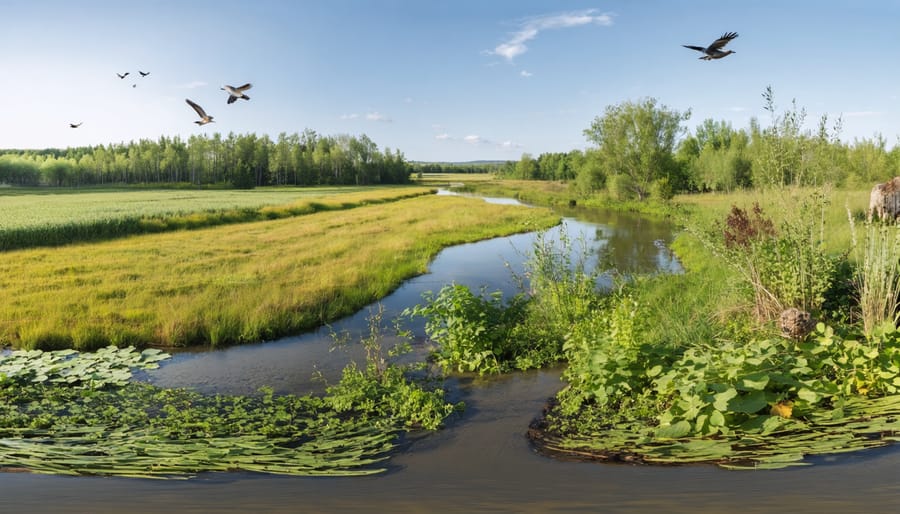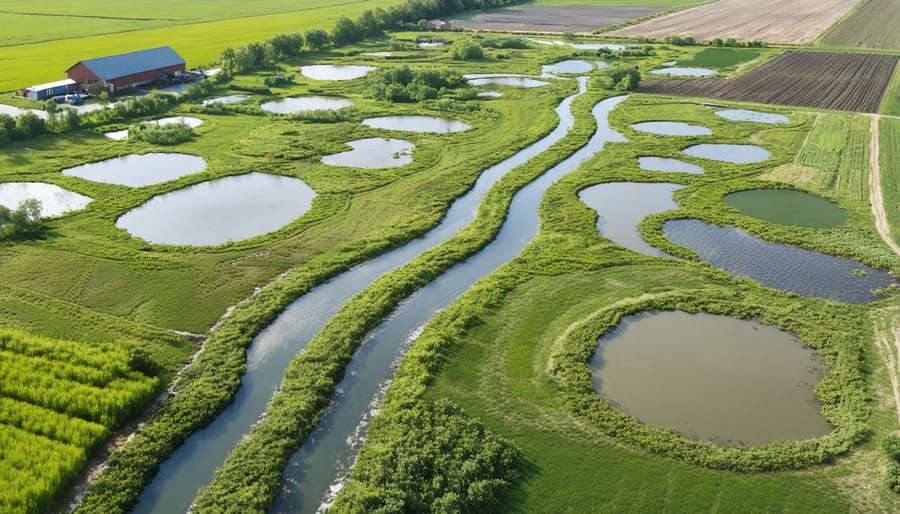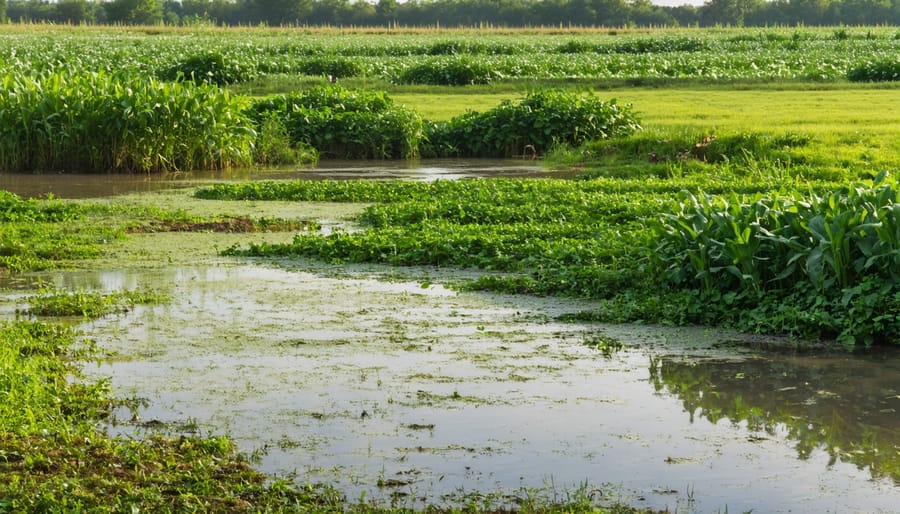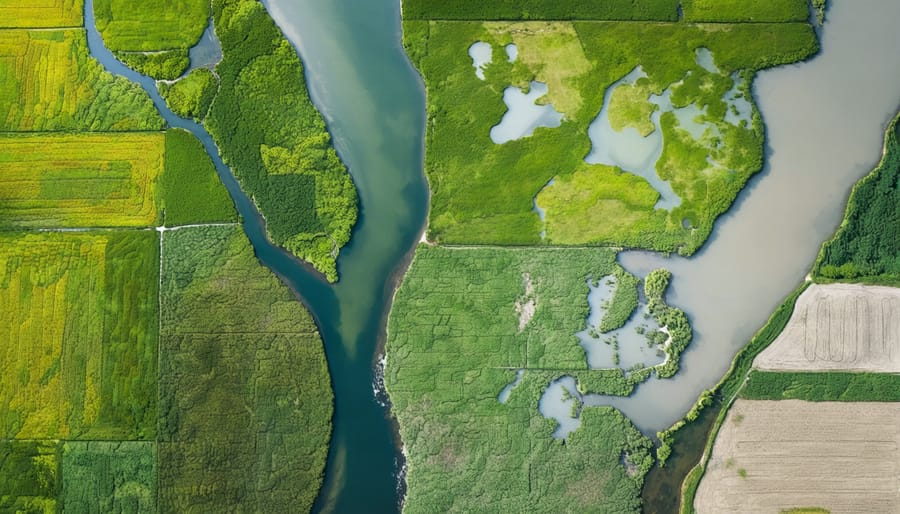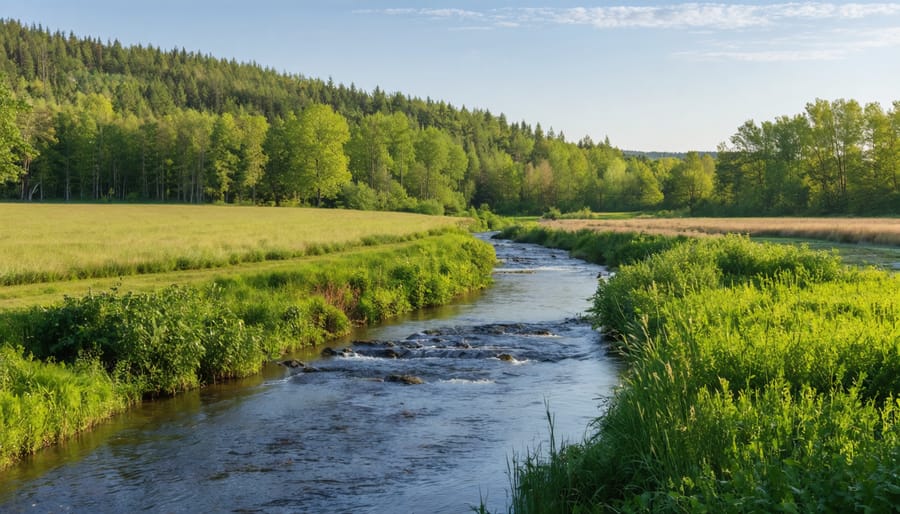Freshwater vegetation forms the backbone of Alberta’s most productive agricultural ecosystems, supporting everything from soil stability to crucial wildlife habitat. Along the banks of the Bow and North Saskatchewan Rivers, native aquatic plants like cattails and bulrushes naturally filter agricultural runoff, protecting water quality for downstream farms. These plant communities also create essential buffers that prevent soil erosion, particularly during spring flooding – a growing concern for producers managing lands near water bodies. For Alberta farmers, understanding and working with these natural systems offers practical solutions for both environmental stewardship and operational efficiency. From integrated pest management to natural filtration of excess nutrients, freshwater vegetation provides ecosystem services valued at millions of dollars annually across the province’s agricultural landscapes. This critical green infrastructure requires minimal maintenance while delivering maximum benefit, making it an increasingly important tool as producers adapt to changing environmental conditions and evolving sustainability requirements.
Native Freshwater Plants in Alberta’s Agricultural Systems
Emergent Plants: Nature’s Water Filters
Emergent plants, particularly cattails and bulrushes, are nature’s own water filtration system, playing a vital role in maintaining healthy farm waterways across Alberta. These hardy plants, which grow along the edges of ponds, dugouts, and wetlands, act as living filters that help restore wetland ecosystems and improve water quality naturally.
Cattails, with their distinctive brown seed heads and tall stalks reaching heights of 1.5 to 3 metres, excel at removing excess nutrients and pollutants from water. Their extensive root systems trap sediments and filter out agricultural runoff, including excess nitrogen and phosphorus. This natural filtration process can reduce the need for costly water treatment systems on your farm.
Bulrushes, another common sight in Alberta’s wetlands, work similarly but offer additional benefits. Their dense stands provide excellent erosion control along water edges and create natural barriers that slow water movement, allowing more time for filtration. During winter, these plants continue to filter water even when dormant, making them year-round allies in water management.
For Alberta farmers, incorporating these plants into existing water features can lead to improved water quality for livestock, reduced erosion, and enhanced biodiversity. Many producers have found that maintaining healthy stands of emergent plants also attracts beneficial wildlife, including natural pest controllers like birds and amphibians.
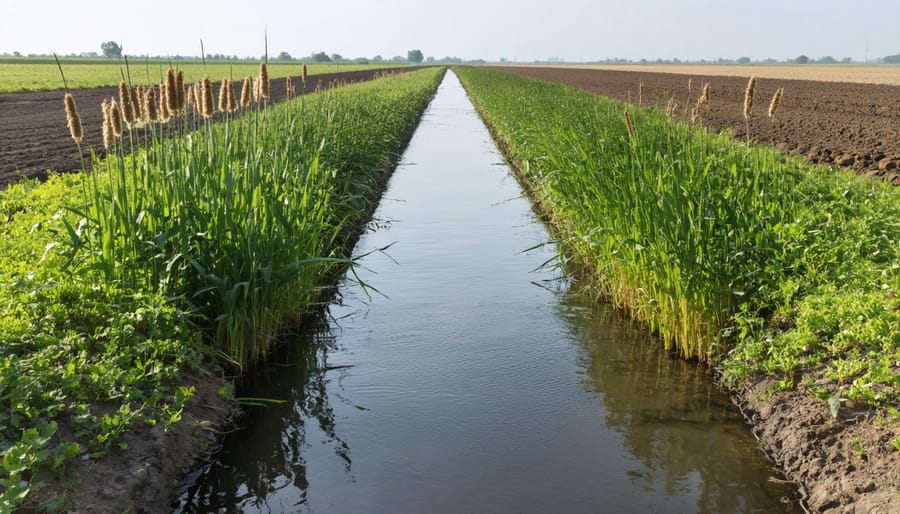
Submerged Vegetation: The Hidden Helpers
Beneath the surface of our freshwater ponds and lakes lies a remarkable network of underwater plants that play a crucial role in maintaining healthy aquatic ecosystems. These submerged plants, including species like Canadian waterweed and coontail, act as nature’s water filtration system, helping to maintain the delicate balance that supports our agricultural operations.
Here in Alberta, these underwater helpers actively remove excess nutrients from farm runoff, particularly nitrogen and phosphorus, which could otherwise lead to algal blooms. Local studies have shown that areas with healthy submerged vegetation can reduce nutrient levels by up to 30% compared to areas without this beneficial plant life.
These plants also provide essential habitat for beneficial insects and small fish that help control pest populations naturally. For farmers managing irrigation ponds, maintaining healthy submerged vegetation can significantly improve water quality for livestock and crops. A well-balanced underwater ecosystem reduces the need for artificial filtration and chemical treatments.
To encourage healthy submerged vegetation in your farm ponds, maintain consistent water levels and avoid over-clearing. Many Alberta farmers have found success by introducing native species like Richardson’s pondweed, which thrives in our local conditions while providing excellent nutrient cycling benefits. Remember that these underwater plants work alongside surface vegetation to create a complete ecosystem that supports sustainable farming practices.
Environmental Benefits for Farm Water Management
Natural Erosion Control
In Alberta’s freshwater ecosystems, vegetation plays a crucial role in preventing soil erosion and maintaining water quality, making it an essential component of effective soil health management. The extensive root systems of native plants like cattails and sedges create a natural mesh that holds soil particles together, particularly along streambanks and wetland edges.
These plant networks act as living barriers, reducing the impact of rainfall and slowing water flow across the landscape. During spring runoff, when erosion risks are highest, established vegetation can reduce soil loss by up to 95% compared to bare ground. This natural protection is especially valuable for farmers managing land near water bodies, where maintaining bank stability is crucial for preserving valuable farmland.
Beyond soil retention, freshwater vegetation filters sediments and excess nutrients from agricultural runoff. Prairie wetland plants like bulrushes and water plantain naturally trap suspended particles, while their root systems absorb excess nitrogen and phosphorus that might otherwise impact water quality. This filtering action helps maintain cleaner water for livestock and irrigation while supporting local biodiversity.
For Alberta farmers, encouraging natural vegetation growth along waterways creates self-sustaining erosion control that requires minimal maintenance once established. Many producers have found success by maintaining buffer zones of native vegetation along creeks and wetlands, reporting improved bank stability and reduced sediment issues in their water sources. This approach not only protects the land but also contributes to the long-term sustainability of farm operations.
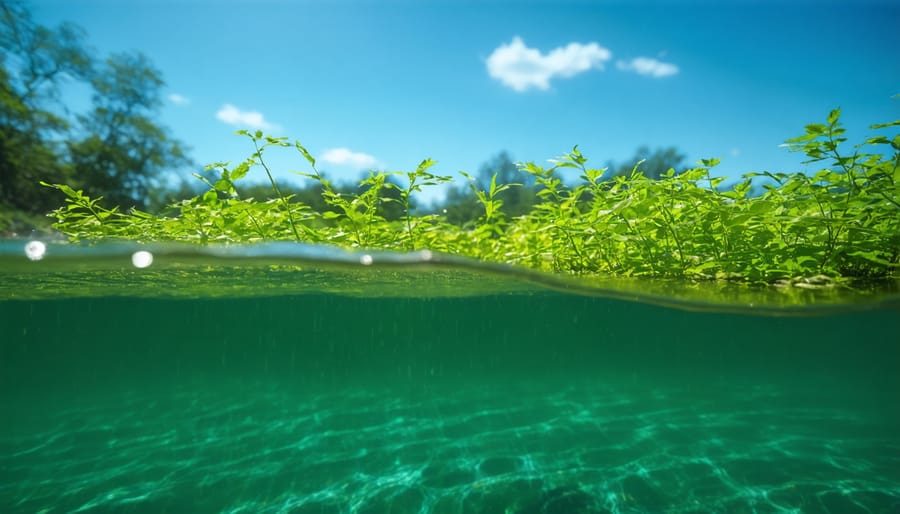
Water Purification Systems
Natural vegetation in our freshwater systems acts as highly efficient biological filters, helping to protect our water resources from agricultural runoff. Here in Alberta, we’ve seen remarkable success stories where farmers have integrated buffer zones of native plants along waterways to reduce nutrient loads from their fields.
Plants like cattails, bulrushes, and water sedges are particularly effective at removing excess nutrients and pollutants from water. These species use their extensive root systems to absorb nitrogen and phosphorus, common components in fertilizers that can otherwise harm aquatic ecosystems. For example, a 10-metre buffer strip of native vegetation can filter out up to 80% of agricultural runoff before it reaches water bodies.
Local farmer Mike Thompson from Red Deer County shares his experience: “After establishing a natural vegetation buffer along our creek, we’ve noticed significantly clearer water downstream. It’s also created a haven for beneficial insects that help with pest control in our crops.”
The process, known as phytoremediation, works through several mechanisms. Plant roots trap sediment, preventing soil erosion. Meanwhile, beneficial bacteria living among the root systems break down harmful compounds into harmless elements. These natural systems are particularly valuable in areas where conventional water treatment infrastructure might be impractical or cost-prohibitive.
For best results, consider implementing a diverse mix of native species. This creates a more resilient system and provides year-round filtration benefits. The Alberta Riparian Habitat Management Society recommends starting with fast-growing species like willows and gradually introducing slower-growing, long-lived plants for sustainable, long-term water protection.
Practical Implementation for Alberta Farmers
Seasonal Management Techniques
Managing freshwater vegetation requires a thoughtful approach that changes with Alberta’s distinct seasons. During spring, as ice melts and water levels rise, focus on reinforcing existing vegetation barriers and introducing new native species. Many local farmers have found success by incorporating traditional water management practices that work with natural cycles rather than against them.
Summer months demand active monitoring of water quality and plant growth. Maintain buffer zones between agricultural areas and water bodies, keeping vegetation trimmed to optimal heights of 15-20 centimetres. This helps prevent excess nutrient runoff while supporting beneficial insects and wildlife.
As autumn approaches, prepare for dormancy by harvesting any useful plant material and removing debris that could cause spring flooding. Document which species thrived and which struggled to inform next year’s planning. Consider collecting seeds from successful native plants for future use.
Winter management focuses on protecting established root systems. Leave adequate plant cover to prevent soil erosion when spring melt begins. Many Alberta farmers use snow fencing to create natural moisture reserves, which helps vegetation bounce back quickly in spring.
Year-round, maintain detailed records of water levels, plant health, and any challenges encountered. This data proves invaluable for long-term planning and adapting to changing conditions. Connect with local agricultural extension services for specific guidance on species selection and maintenance techniques suited to your area’s unique conditions.
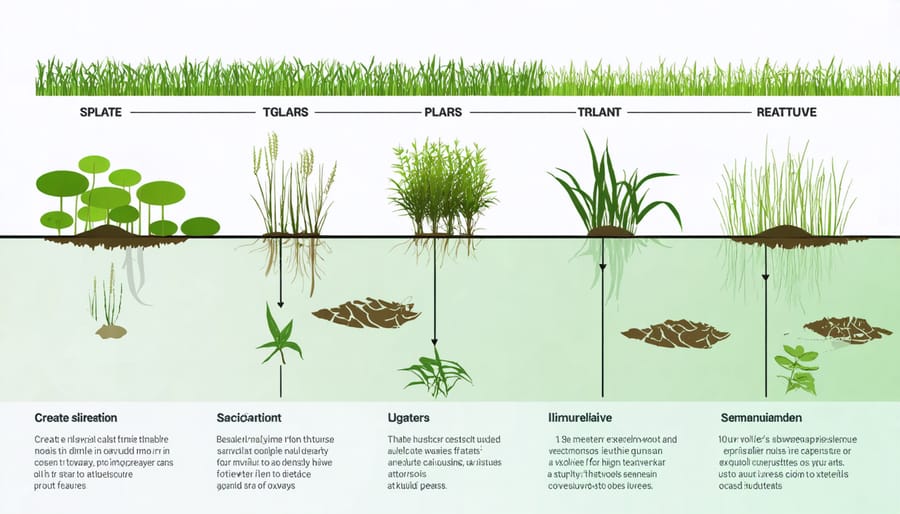
Local Success Stories
The Henderson family farm near Red Deer stands as a shining example of successful aquatic vegetation management in Alberta. After implementing a controlled wetland system in 2018, they’ve reported a 30% reduction in fertilizer use while maintaining crop yields. Their innovative approach involves using cattails and bulrushes as natural filters, creating a sustainable water management system that supports both agriculture and local wildlife.
In Sturgeon County, the Petersens’ multi-generation farm has transformed what was once problematic pond vegetation into an asset. By strategically managing duckweed and water lilies, they’ve developed a natural water purification system that provides irrigation for their organic vegetable operation. Their success has inspired neighbouring farms to adopt similar practices.
The Mountain View Colony near Cardston demonstrates how community-based approaches can yield remarkable results. Their collaborative effort to restore a 5-hectare wetland area has not only improved water quality but also created a sustainable water source for their livestock. The colony’s careful management of aquatic plants has created a balanced ecosystem that supports their agricultural needs while providing habitat for local wildlife.
These success stories highlight a growing trend among Alberta farmers who view aquatic vegetation not as an obstacle but as an opportunity. Local agricultural extension officer Sarah Thompson notes, “What we’re seeing is a shift in perspective. Farmers are increasingly recognizing that working with natural systems, rather than against them, can lead to more sustainable and profitable operations.”
Getting Started: First Steps
Starting your journey with freshwater vegetation management doesn’t have to be overwhelming. Begin by conducting a thorough assessment of your water bodies during early spring, just as the ice melts. Take note of existing plant species and water conditions, including depth and flow patterns.
For Alberta farmers, the first practical step is mapping your water sources. Use a simple notebook or smartphone to document the locations of ponds, dugouts, and natural wetlands on your property. This baseline information will prove invaluable as you develop your management strategy.
Consider starting small with a test area of about 100 square metres. This allows you to experiment with different management techniques without committing extensive resources. Many successful Alberta farmers recommend beginning with native species like cattails or bulrushes, which are well-adapted to our climate and provide excellent water filtration benefits.
Essential tools for getting started include:
– Basic water testing kit
– pH meter
– Temperature gauge
– Plant identification guide
– Protective gear (chest waders, gloves)
– Basic pruning tools
Remember to connect with your local agricultural extension office or conservation authority before making any significant changes. They can provide region-specific advice and ensure compliance with local regulations. Many experienced farmers in our community are also willing to share their knowledge – don’t hesitate to reach out to neighbours who have successfully managed their water vegetation.
Throughout Alberta’s diverse freshwater ecosystems, vegetation plays a vital role in maintaining healthy agricultural landscapes and supporting sustainable farming practices. As we’ve explored, these plants contribute to water quality, prevent soil erosion, and create valuable wildlife habitats that benefit our farming operations.
By understanding and protecting the natural vegetation in our wetlands, ponds, and waterways, we’re investing in the future of Alberta agriculture. These plants are our partners in creating resilient farming systems that can withstand environmental challenges while supporting productive operations.
We encourage you to take action in your farming practice by implementing buffer zones with native vegetation around water bodies, maintaining existing wetland plants, and considering how these natural systems can work alongside your agricultural activities. Remember that even small changes, like preserving cattail stands or maintaining riparian areas, can have significant positive impacts on your land’s health and productivity.
Local agricultural extension offices and conservation authorities are excellent resources for guidance on integrating freshwater vegetation management into your farm plan. By working together as a farming community, we can preserve these valuable plant ecosystems while maintaining profitable and sustainable agricultural operations for generations to come.
Your role in stewarding these freshwater plant communities is crucial for the future of Alberta’s agricultural landscape. Let’s continue to learn from and work with these natural systems for the benefit of our farms and our environment.

